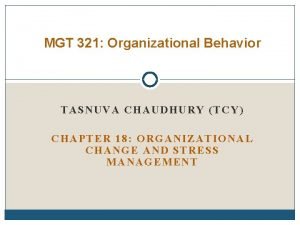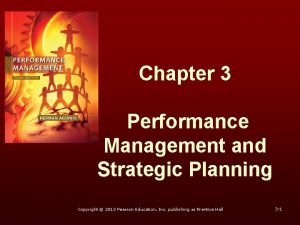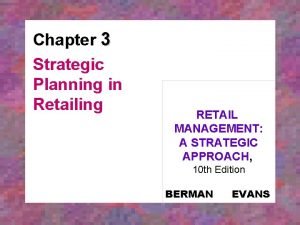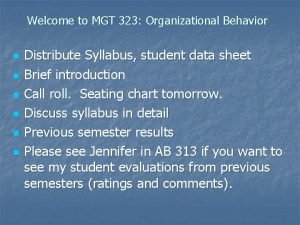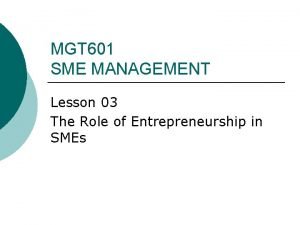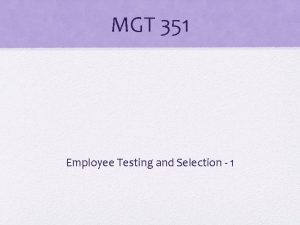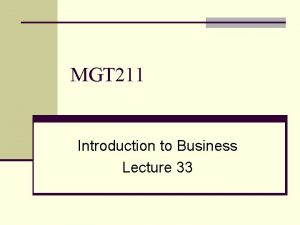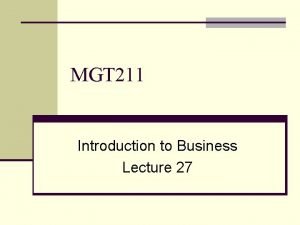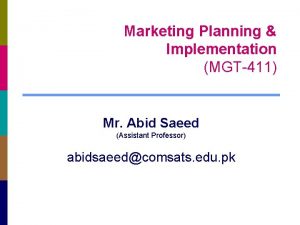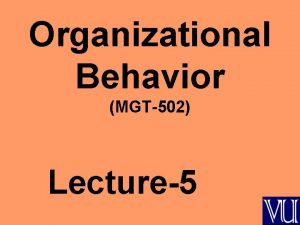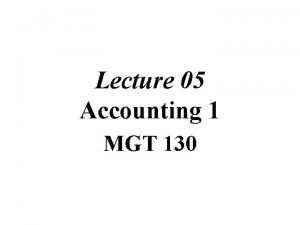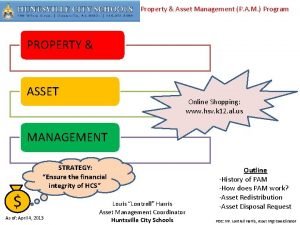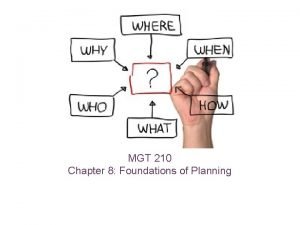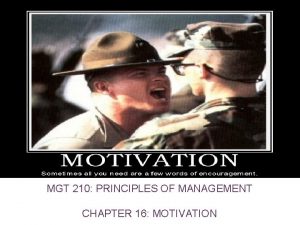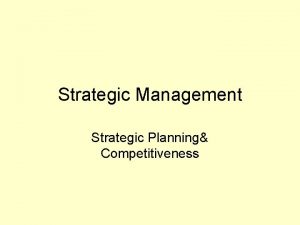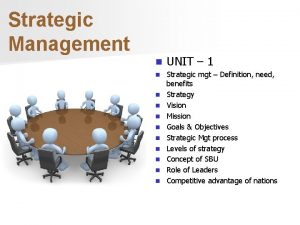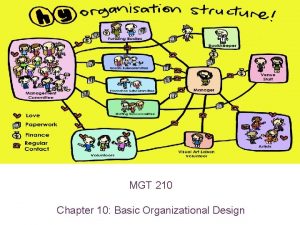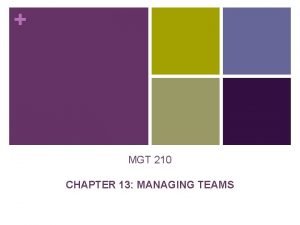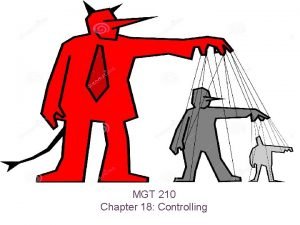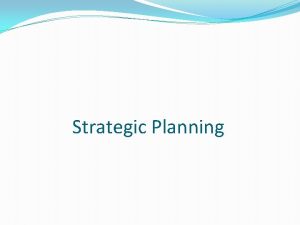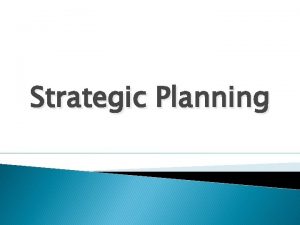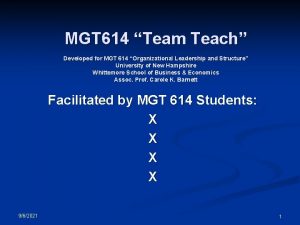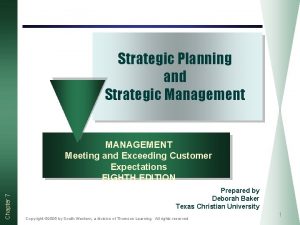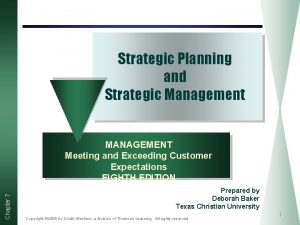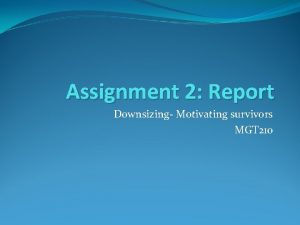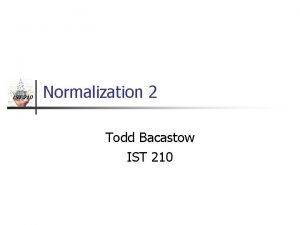MGT 210 Chapter 9 STRATEGIC MANAGEMENT PLANNING Strategic
























- Slides: 24

+ MGT 210 Chapter 9: STRATEGIC MANAGEMENT & PLANNING

+ Strategic Management This is what manager’s do to develop the organization’s strategies. This involves all the basic management functions: planning, organizing, leading & controlling. n Organizational strategies are the plans for: n how the organization will do whatever its in business to do n how it will compete successfully n how it will attract and satisfy its customers in order to achieve its goals. n Business model is how a business is going to make money. It focuses on two things: n 1. whether customers will value what the company is providing n 2. whether the company can make money doing it

Importance of Strategic + Management There are three reasons n There is positive relation between planning and performance. n Managers can cope with uncertainty by using the strategic management process to examine the relevant factors and decide what actions to take. n Strategic management helps to focus each part of the organization so that they can work towards achieving the company’s goals.

+ The Strategic Management The strategic management process is a six-step process that involves strategy planning, implementation and evaluation

+ Step 1: identifying the organization’s current mission, goals and strategies A mission is a statement of purpose. Defining the mission forces managers to identify what the business needs to do. n These statements provide clues to what these organization’s see as their purpose

Step 2: Doing an External + Analysis Managers should examine the economic, demographic, political/legal, sociocultural, technological and global components to see the trend and change

+ Step 3: Doing an internal analysis n An organization’s resources are its assets: financial, physical, human and intangible. n Its capabilities are its skills and abilities in doing the work activities needed in its businesses - how it does the work. n The major value creating capabilities are its core competencies

+ Step 4: Formulating Strategies Managers should consider the realities of the external environment and their available resources and capabilities

+ Step 5: Implementing Strategies performance will suffer if the strategies aren’t implemented properly

+ Step 6: Evaluating results How effective have the strategies been at helping the organization reach its goals? What adjustments are necessary

+ Corporate Strategies n A strategy that determines what businesses a company is in or wants to be in, and what it wants to do with those businesses. n Its based on the mission and goals of the organization and the roles that each business unit of the organization will play n Three types of corporate strategies: n Growth n Stability n Renewal

+ Growth When an organization expands the number of markets served or products offered, either through its current or through new business n An organization that grows using concentration focuses on its primary line of business and increases the number of products offered or markets served in this primary business n Vertical integration n Horizontal integration n Diversification

+ Stability An organization continues to do what it is currently doing. The organization doesn’t grow but doesn't fall behind as well

+ Renewal strategies that address declining performance. The two types of renewal strategies are retrenchment and turnaround strategies n A retrenchment strategy is a short run revival strategy used for minor performance problems. n This strategy helps an organization stabilize operations, revitalize organizational resources and capabilities and prepare to compete once again. n When an organization’s problem are more serious, more drastic actions – the turnaround strategy is needed. n Managers do two things for both renewal strategies: n n cut costs restructure organizational operations.

+ Managing Corporate Strategies When an organization’s corporate strategy encompasses a number of business, managers can manage this collection, or portfolio using a toll called corporate portfolio matrix.

+ BCG Matrix n The dogs should be sold off or liquidated as they have low market share in markets with low growth potential. n Mangers should milk cash cows for as much as they can, limit any new investment in them and use the large amount of cash generated to invest in stars and question marks with strong potential to improve market share. n The stars will eventually develop into cash cows as their markets mature and sales growth slows

+ Competitive Strategies a strategy of how an organization will compete in its businesses n When an organization is in several different businesses, those single businesses that are independent and have their own competitive strategies are called strategic business units (SBUs) n Competitive advantage sets an organization apart – its distinctive edge. n This can come from the organization’s core competencies by doing something that other cannot do or doing it better than others can do it. n Competitive advantage can arise from holding a certain kind of resource n If a business is able to continuously improve the quality and reliability of its products, it may have a competitive advantage that cant be taken away

+ Sustaining Competitive Advantage An important part of doing this is an industry analysis, which is done using the Porter’s five forces model.

+ Choosing a Competitive Strategy An appropriate competitive strategy fits the competitive strengths of the organization and the industry in it n When an organization competes on the basis of having the lowest costs, it is following a cost-leadership strategy. A lowcost leader is highly efficient. n A company that competes by offering unique products that are widely valued by customers is following a differentiation strategy. . n A focus strategy involves a cost strategy or differentiation strategy in a certain part of the market or niche. Functional strategies are strategies utilized by an organization’s various functional departments to support the competitive advantage.

+ Important Organizational Strategies Three strategies are important in today’s corporate world n E- business strategies n Customer service strategies n Innovation strategies

+ E-Business strategy Managers use e-business strategies to develop a sustainable competitive advantage. n A cost leader can use e-business to lower costs in a variety of ways n A differentiator needs to offer products or services that customers perceive and value as unique. Finally, because the focuser targets a narrow market segment with customized products, it might provide chat rooms or discussion boards for customers to interact with others who have common interests, design niche Web sites that target specific groups with specific interest

+ Customer service strategies n Such strategies involve giving customers what they want, communicating effectively with them, and providing employees with customer service training n Managers should know what’s going on with customers. They need to find out what customers liked and didn’t like about their purchase encounter—from their interactions with employees to their experience with the actual product or service n An organization’s culture is important to providing excellent customer service. This typically requires that employees be trained to provide exceptional customer service

+ Innovation Strategies n Managers must first decide where the emphasis of their innovation efforts will be n Basic scientific research requires the most resource commitment because it involves the nuts-and-bolts work of scientific research n A focus on process development. Using this strategy, an organization looks for ways to improve and enhance its work processes.

 210 210 210
210 210 210 Mgt 321 chapter 2
Mgt 321 chapter 2 Strategic planning vs tactical planning
Strategic planning vs tactical planning Strategic competitiveness
Strategic competitiveness Strategic analysis and choice in strategic management
Strategic analysis and choice in strategic management Strategic planning for retail business
Strategic planning for retail business Performance management and strategic planning
Performance management and strategic planning Explain why strategic planning is important to all managers
Explain why strategic planning is important to all managers Objectives of strategic planning in retailing
Objectives of strategic planning in retailing Chapter 2 strategic planning for competitive advantage
Chapter 2 strategic planning for competitive advantage Mgt 323
Mgt 323 Scope of financial accounting
Scope of financial accounting Mgt 601
Mgt 601 Mgt 351 nsu course outline
Mgt 351 nsu course outline Mgt340 group assignment
Mgt340 group assignment Luyana211
Luyana211 A product can be
A product can be Mgt 411
Mgt 411 Mgt 385
Mgt 385 Portfolio plan example
Portfolio plan example Mgt502
Mgt502 Mgt 130
Mgt 130 Financial strategies in retailing
Financial strategies in retailing K12 asset mgt
K12 asset mgt Walter ferrier
Walter ferrier

